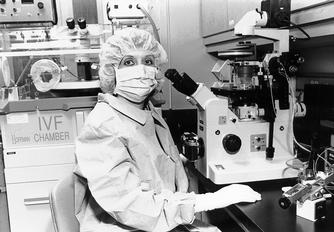
Dr. Maria Bastias says new equipment is bolstering VUMC's reproductive medicine services
Changes to bolster VUMC's reproductive medicine services
Reproductive medicine at Vanderbilt University Medical Center is undergoing some changes.
There's a new name. What used to be called the Center for Fertility and Reproductive Research is now the Vanderbilt Center for Reproductive Medicine (VCRM).
There's a new director. Dr. Esther Eisenberg, associate professor of Obstetrics and Gynecology, is now director.
There's also a new location for in vitro fertilization procedures. Both the IVF laboratory and IVF procedure room have moved from Vanderbilt University Hospital to Medical Center North, where the VCRM is located. The new laboratory is equipped with a state-of-the-art air ventilation and monitoring system that provides an optimal environment for fertilization and early embryo development.
But what has not changed is the center's reputation for helping infertile couples conceive.
In vitro fertilization has been performed at VUMC since November 1981. It was the fourth such program to open in the United States and the third to announce a pregnancy. The program's success rate has always been above the national average. Currently, Vanderbilt's delivery rate per embryo transfer is 27 percent for patients under 40 years of age, compared with the national delivery rate of 21 percent, Eisenberg said.
Couples who come to VUMC for an IVF procedure now come to one area for their complete care, Eisenberg said.
"Patients always went home the same day, but now it's in the outpatient area they're used to coming to. They see the same clinical personnel and the same nurses who have been involved in their care all along. It's more point-of-service and it's more comfortable for the patients," she said.
During the early development of the program, the eggs were removed laparascopically so the procedure had to be performed in an operating room.
"It was only after 1985, with the advent of the development of transvaginal ultrasound to guide aspeiration of the follicles that you could even conceive of having in vitro fertilization as an office-based procedure."
There have been seven retrievals performed since the move in August and two resulting pregnancies, Eisenberg said.
Eisenberg said she is especially pleased with the new air filtration system in the laboratory – a system that is located in only a handful of laboratories throughout the country .
"We're much happier with the environment the eggs, sperm and embryos are exposed to," Eisenberg said. "Our laboratory conditions have never been better."
Dr. Maria C. Bastias, assistant professor of Obstetrics and Gynecology, is director of the IVF laboratory. She said the new HEPA (High Efficiency Particulate Air) filtration system is reducing the number of particles floating in air of the laboratory, making the conditions more favorable for fertilization and growth of the developing embryos.
Bastias said positive airflow is also needed to make the pressure in the laboratory higher than outside the area.
"You can prevent contaminants from coming into the lab. A positive airflow pushes them away," she said.
The air quality sensor system is equipped with an airborne sensor which monitors the quality of the air continuously and is providing some very significant information about the working conditions inside the IVF lab.













